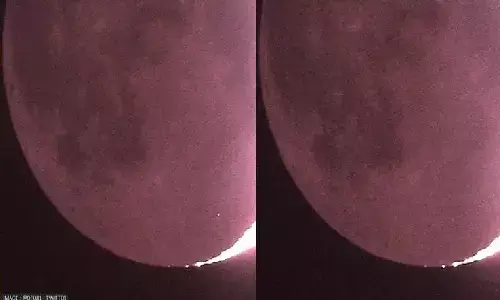
A Japanese astronomer filmed an astonishing moment when a meteorite blasted onto the surface of the moon, causing a crater. On February 23, a Japanese astronomer captured what was termed a ‘lunar impact flash’ as the meteorite struck the moon. Daichi Fuji, the head of astronomy at Hiratsuka City Museum, captured the split-second film at about 8.15 p.m. (11.15 GMT) from his house in Hiratsuka, Japan.
“I was able to catch the biggest lunar impact flash in my observation history! This is a picture of the lunar impact flash that appeared at 20:14:30.8 on February 23, 2023, taken from my home in Hiratsuka (replayed at actual speed). It was a huge flash that continued to shine for more than 1 second. Since the moon has no atmosphere, meteorites, and fireballs cannot be seen, and the moment a crater is formed, it glows,” tweeted Daichi Fujii as he posted the video.
“At the time of observation, there was no artificial satellite passing over the lunar surface, and from the way it shines, it is likely a lunar impact flash,” Fujii wrote.
According to Fuji, the space rock appears to have fallen near the Ideler L crater, which is slightly northwest of the Pitiscus crater on the moon. He claimed that the ‘produced crater is enormous’ and the striations are apparent since he captured such a strong light on his zoom camera. He argued that fireballs and meteorites are not visible on the moon because there is no atmosphere, therefore craters ‘glow’ when they develop.
“At that time, the altitude of the moon was only seven degrees, and I was glad that I was able to hold on until the last minute,” he added.
More than 100 meteorites the size of ping pong balls impact the moon’s surface every day: NASA
According to Bill Cooke, head of NASA’s Meteoroid Environment Office at NASA’s Marshall Space Flight Center in Alabama, more than 100 meteorites the size of ping pong balls impact the moon’s surface every day.
“That adds up to roughly 33,000 meteorites per year. Despite their small size, each of these ping pong-ball-size rocks impacts the surface with the force of 7 pounds (3.2 kilograms) of dynamite,” Cooke said.






